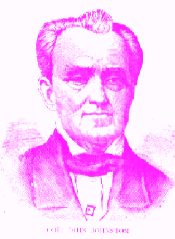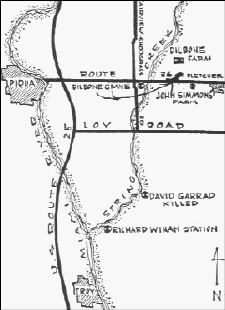The War of 1812
The
migration into Shelby County, Ohio, was negatively impacted by a renewed fear of Indians
during the War of 1812. Even though local men joined the Army, there appears to have been
little military activity in this area and no record of combat deaths. After the War ended,
the settlers began to inhabit parts of the county other than Loramie Creek and the Great
Miami River basin.
There
were a number of Indians near Shelby County.
After the War of 1812, more than 6,000 Indians had settled near Colonel John Johnston’s home in
Piqua. Although most were peaceful, there were some troublemakers. |

Colonel John
Johnston |
| According to Miss Ann Conklin’s recollections of Sidney in the early
years after it was platted, "[a building] was owned by a man named Beatty, whose
principal occupation seems to have been the selling of the roughly distilled
whiskey made in the vicinity. Such as it was, it was eagerly drank by the Indians, of whom
there were then plenty, on their way to and from the office of the agent, Johnston, at
Piqua. One hundred, or more, on their ponies, in all their savage trappings, was no
unusual sight in Sidney in those days."
Another Sidney newspaper column [undated] written by Blanche Gearhart on
the ‘Early History of Sidney’ stated that "an old fort stood on Main
street near the present site of the Catholic church. Twenty-five or thirty men were
stationed there as protection against the Indians. There were two tribes of Indians near
Sidney, the Delawares and the Potawataines. The Delawares were friendly to the whites but
the Potawataines were war-like."
Indians would often trade with the white settlers, but two
Shawnees, Tecumseh and his brother had sided with the British during the War
of 1812 and openly encouraged attacks on the white settlers.
In 1813, Henry Dilbone, his wife, and a
nearby neighbor, David Garrard, were
massacred in northern Miami County by a Shawnee Indian named Mingo George. After Mingo
was found and killed, the Dilbone’s four children were taken in and raised by
neighbors.
When a memorial was placed
on the site years later, local historian Leonard U. Hill closed the ceremony with these
words, "May all who view this marker be reminded that the present day comforts of
life, the ease of acquiring a living and our assurance of security were not always thus.
All of our pioneering ancestors endured many great hardships and a few, as the Dilbones,
made the supreme sacrifice."

'Pioneer' segment written in
October, 1997 by Sherrie Casad-Lodge
[ Back to Pioneer Index ] |

